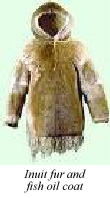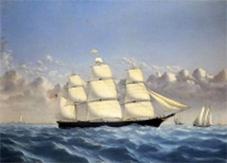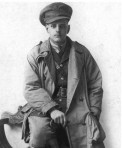 Man’s need for protection against the elements – rain, wind, snow – goes back to the Stone Age. Homo Sapiens quickly learned from nature how to equip himself with an impermeable outer layer of clothing. The fur of the animals he hunted was thick, dense and coated with natural oils which repelled water and kept him warm and dry. All over the world, civilizations through history have made their clothes waterproof or water repellant. The Inca Indians extracted sap from leaves and bark such as the rubber plant, to smear onto their clothes. The Inuit Indians and the Vikings soaked their clothes in fish oil to achieve the same result. The Saxons smeared animal fat on their loosely woven sack cloth to minimise absorbency and shed water.
Man’s need for protection against the elements – rain, wind, snow – goes back to the Stone Age. Homo Sapiens quickly learned from nature how to equip himself with an impermeable outer layer of clothing. The fur of the animals he hunted was thick, dense and coated with natural oils which repelled water and kept him warm and dry. All over the world, civilizations through history have made their clothes waterproof or water repellant. The Inca Indians extracted sap from leaves and bark such as the rubber plant, to smear onto their clothes. The Inuit Indians and the Vikings soaked their clothes in fish oil to achieve the same result. The Saxons smeared animal fat on their loosely woven sack cloth to minimise absorbency and shed water.
 The Industrial Revolution heralded the shift from natural waterproofing of fabrics to chemical additives. In 1816 in an attempt to find practical uses for the waste products generated by the production of steel, Charles Macintosh, a Glaswegian chemist, developed a solvent for rubber using naptha, a by-product of the distillation of coal tar. He used this glue to stick two layers of woven, woollen cloth together which was then pressed with rollers, a process which he patented in 1823.
The Industrial Revolution heralded the shift from natural waterproofing of fabrics to chemical additives. In 1816 in an attempt to find practical uses for the waste products generated by the production of steel, Charles Macintosh, a Glaswegian chemist, developed a solvent for rubber using naptha, a by-product of the distillation of coal tar. He used this glue to stick two layers of woven, woollen cloth together which was then pressed with rollers, a process which he patented in 1823.
The result was a completely waterproof fabric, albeit stiff and with a strong smell of rubber and a tendancy to melt in hot weather and stiffen in cold weather. Another problem was discovered when tailors began to make coats out of this revolutionary fabric – wherever it was stitched, it leaked.
Charles Macintosh then teamed up with Thomas Hancock, a competitor in the field of waterproof materials, and developed the process of vulcanisation (patented in 1843). By heating the latex film and combining it with sulphur and an accelerator, the rubber became much stronger and more elastic resulting in a fabric with a softer handle which did not become sticky or stiff in extreme weather conditions. Seams were also ‘proofed’ using the same process so the coats were totally waterproof. However, in use, body heat condensed and made the wearer very sweaty because the fabric and coating did not breathe.
 By the middle of the nineteenth century, developments in the maritime industry had a major influence on the cloth used in rainwear. Heavy flax sails, coated in linseed oil, had given way to lighter, stronger and larger cotton sails which greatly increased the speed and efficiency of the British clipper fleet. This strong two-ply cotton yarn was also woven for waterproof clothing which, when coated with linseed oil, became the most effective fabric for sailors until well into the twentieth century.
By the middle of the nineteenth century, developments in the maritime industry had a major influence on the cloth used in rainwear. Heavy flax sails, coated in linseed oil, had given way to lighter, stronger and larger cotton sails which greatly increased the speed and efficiency of the British clipper fleet. This strong two-ply cotton yarn was also woven for waterproof clothing which, when coated with linseed oil, became the most effective fabric for sailors until well into the twentieth century.
Wartime and the need to keep soldiers dry and warm created yet more innovative developments. In 1879 Thomas Burberry patented gabardine, a breathable, weatherproof and tearproof fabric. The Egyptian cotton yarn was first waterproofed and then tightly woven into a diagonal twill. This diagonal pattern caused water to form into droplets and then to flow downwards.
 Gabardine was first used in coats for British officers during the Boer War and by the outbreak of World War 1 the classic trenchcoat was regulation issue for British airmen and soldiers and retains its iconic status today.
Gabardine was first used in coats for British officers during the Boer War and by the outbreak of World War 1 the classic trenchcoat was regulation issue for British airmen and soldiers and retains its iconic status today.
The 1930’s saw a major leap forward in the process of waterproofing cloth when John Barbour & Sons began using paraffin wax to impregnate cotton cloth. This involved a cupro-ammonia treatment (which also imparted the distinctive olive colour to the cloth) followed by a soft wax coating. The result was a high performance fabric – waterproof, breathable and much softer than anything before it – quickly taken up by motorcyclists, country sports enthusiasts, gamekeepers, farmers and more recently the ‘county set’.
 Technical and chemical developments in the late twentieth century have produced a plethora of fabrics and coatings for a wide range of end uses from the lightest weight micro yarns with ‘climate control’ breathability for mountaineers to hardwearing shooting jackets in woollen tweed with a waterproof interlining (Gortex).
Technical and chemical developments in the late twentieth century have produced a plethora of fabrics and coatings for a wide range of end uses from the lightest weight micro yarns with ‘climate control’ breathability for mountaineers to hardwearing shooting jackets in woollen tweed with a waterproof interlining (Gortex).
Whether clothes are described as water repellant or waterproof, almost all require reproofing after cleaning. Cocoon is one of the few companies making stylish, totally waterproof raincoats which are machine washable and do not need re-proofing. The cotton rich fabric is Teflon coated on the outside with a breathable polyurethane coating on the inside. The coats are lightweight and packable (supplied with a carrying pouch) and detachable linings can be added for extra warmth.
